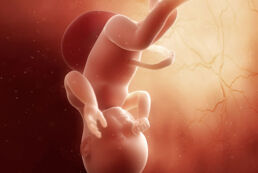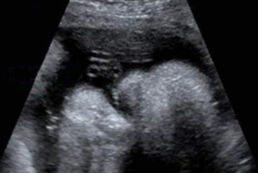Baby's Height and Weight
At 39 weeks of pregnancy, the baby is about 50-51 centimeters tall, the size of Kacang Panjang(Yardlong Bean) Beans. The baby weighs about 3300 grams.
Development of the Baby

If a 39-week-old baby is born, she is mature enough to live comfortably in the outside world. Yet brain cells continue to grow. The development of brain cells in the womb is very valuable. In the years when this value was not known, babies born by planned cesarean section were taken from the womb at 38 weeks of age. Now, fortunately, if there is no medical necessity, the baby must be at least 39 weeks old in planned cesareans.
At 39 weeks of pregnancy, the baby’s fine hair, called Lanugo, was largely shed.
The Vernix Caseosa (Varnish Caseosa) layer, which forms on your baby’s skin surface at 39 weeks of pregnancy, continues to provide temperature control of his/her body and keep his/her skin moist. This structure will also facilitate the passage of the baby through the birth canal at birth. In natural birth practices, it is ensured that the vernix layer remains on the babies’ skin for a while after birth, that is, the baby is not washed immediately. Thus, it is ensured that this oily layer continues to keep and nourish the baby’s skin during the adaptation to the outside world. In the first bath, some of the vernix is washed so that it remains on the baby’s skin.
At 39 weeks of pregnancy, antibodies continue to be passed from mother to baby via the umbilical cord. Thanks to these antibodies, the baby will be prepared for diseases and microbes outside the uterus.
The area around his skin, organs, and some muscles continues to get greasy.
Thanks to this lubrication, your baby’s body will be able to provide temperature control when he/she is born. He will need these fats for his healthy development and survival.
Baby Movements at 39 Weeks Pregnancy
Your baby is moving less because his space is narrowed. But you can still feel the thrust of his tiny hands and feet as he stretches inside.
You may experience pain and painful sensations in your lower region, as it will make movements to settle in the pelvis with its head for birth preparation.
You’ll feel your hiccups in the form of rhythmic little jumps.
It is good to follow their movements as they will move in moments other than sleep. If you do not feel their movements for a while, be sure to talk to your doctor.
Ultrasound Image

In ultrasound images at 36 weeks, your doctor will look at your baby’s position, heart rate, movements and the amount of amniotic fluid.
Your baby should be in the delivery position. Probably his head is down and he has placed his head inside the pelvis, waiting… In the ideal birth position, the baby’s face should face the mother’s spine. However, his/her face may be on the right, left or front. In such cases, the baby can be in the ideal position until birth. If not, the doctor may recommend turning the baby by hand.
In the 39-week baby images, the baby may still stand with its head up, that is, in the sitting position (breech arrival). Before birth, 96percent of babies are turned upside down.
The reasons for the breech posture of the baby until birth are that the baby is small compared to his/her peers in that week, the amniotic fluid is more than necessary and there is laxity in the uterus in those who have previously given birth. There is no condition that babies who stop at breech arrival will be born by cesarean section. If there is no medical condition that may be risky for normal birth in the mother and baby, a doctor experienced in this regard can also have normal breech births. Approximately 50percent of breech births are normal.
Research shows that babies of mothers who prefer to sit rather than lie down while resting have a higher tendency to turn upside down in the last 3 months.
Changes in the Mother's Body
In the last weeks of pregnancy, the expectant mother waits impatiently for the birth. Her belly is down. This is due to the fact that the baby inserts its head into the pelvis.
Since childbirth can happen at any time, it is useful to know the signs of childbirth.
Here are the signs of childbirth at week 39:
– Increase in the number of false contractions (Braxton Hicks),
– Increase in the nesting instinct (being energetic, for example; cleaning and tidying the house incalculably),
– The onset of regular contractions and every 10 or 15 minutes,
– Prolongation of the time of regular contractions, increase in the frequency and severity of contractions,
– Increased severity of contractions when you walk or lie down,
– You feel pain in the lower part of your back and abdomen, that is, in your groins, similar to menstrual pains,
– Diarrhea
– Blood coming from the cervix in the cervix, that is, because the mucus plug is softened (this is also called engagement among the people),
– Frequent need to go to the toilet,
– Insufficient or excessive amniotic fluid (rupture of membranes).
If these symptoms occur, be sure to inform your doctor.If all is well, sexual intercourse is not inconvenient at 39 weeks of pregnancy. The prostaglandin hormone in the man’s semen can trigger labor as it will soften the cervical plug. The fact that the act of ejaculation is like the end of 39 weeks or the beginning of 40 weeks at the earliest may be an advantage for the beginning of labor.
Opening of the amniotic sac
Sometimes amniotic fluid may come in before labor begins. This condition usually occurs in an average of 15percent of pregnancies. Normally, amniotic fluid should come with the baby at birth. However, the arrival of amniotic fluid with rupture of the uterine membranes may also occur before labor contractions or during the initial stage of labor during contractions. The decrease in the amniotic fluid that the baby lives in turns into a disadvantage as the hours pass. Some doctors wait up to 12 hours in such a case, while others may wait between 12-24 hours as long as the baby’s heartbeat is normal. During this waiting period, the doctor and the midwife should perform exercises to initiate labor. If contractions do not begin, the doctor may recommend artificial labor (initiating labor by administering artificial oxytocin hormone). In this process, if the baby is not born with normal birth, the doctor will recommend cesarean section.
Caesarean Births
Although cesarean deliveries may seem like a risk-free birth to some expectant mothers, studies indicate that the risk rate in cesarean deliveries is as high as in normal deliveries. Moreover, in cesarean section, the risk of surgery is taken. Caesarean section surgery is a very important and necessary surgery due to its life-saving feature when performed in compulsory situations. Enjoying it is an obstacle to the mother and baby’s ability to experience their nature.
Some expectant mothers are very afraid of cesarean section surgery and its disadvantages. The disadvantages of cesarean surgery are as follows:
– Risks of surgery,
– Since the baby does not pass through the birth canal, its spine will not be stroked. Therefore, doctors massage the spine of babies born by cesarean section,
– Babies can excrete the secretion in the respiratory tract more in normal birth. In cesarean delivery, the nurse pulls these secretions with a hose after birth,
– Since the mother does not give birth to her baby, she may have difficulty accepting the baby psychologically. He/she may feel anger and guilt for many years because he/she did not give birth normally. If this is the case, professional help may be required,
– Breastfeeding may occur late due to reasons such as the late activation of the prolactin hormone, which provides milk release.
Before cesarean section surgery in hospitals, they make the mother sign a document stating that they accept the risks associated with cesarean section. For this reason, it is useful to know some of these risks in advance. You should ask your doctor anything you have in mind. If your doctor tells you medically that you need to give birth by cesarean section, don’t insist on giving birth normally. Prepare yourself for any eventuality. Do not resist the medical facilities offered for your baby’s and your health.
Points need to be considered
Canbebe on Social Media!
Join our community of mothers and fathers on social media. Be close to caring community, sharing advices between each other on our everyday life with our baby.
